
How to Freeze Cauliflower - Easily! With Step-by-step Photos, Recipe, Directions, Ingredients and Costs
How to Freeze Cauliflower
PDF print
version
If you like frozen cauliflower in the winter, just imagine how good it would
taste if you had picked a head yourself and then quickly froze it at home!
It is also one of the simplest ways to put up a vegetable for the winter. Here's
how to do it, complete instructions in easy steps and completely illustrated.
The cauliflower will taste MUCH better than anything you've ever had from a store.
Directions for Freezing Cauliflower
Ingredients
Equipment
Instructions
Step 1 - Get the cauliflower!
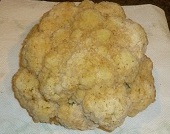 This
is the most important step! You need cauliflower thatt isFRESH and
crisp. Limp, old cauliflower will make nasty tasting frozen
cauliflower.
This
is the most important step! You need cauliflower thatt isFRESH and
crisp. Limp, old cauliflower will make nasty tasting frozen
cauliflower.
Cauliflower are of the best quality when they are tight, before the florets
start to open or turn yellow.Cauliflower are of the best quality when they are tight, before the florets
start to open or turn yellow.
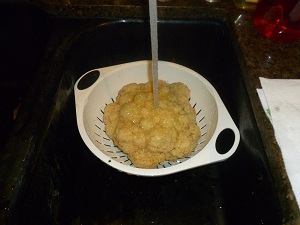 How much cauliflower and where to get it
How much cauliflower and where to get it
You can grow your own, pick your own, or buy them at the farm market or grocery store.
Start with fresh cauliflower - as fresh as you can get.
Step 2
- Wash the cauliflower!
I'm sure you can figure out how to rinse the cauliflower in
plain cold water. Trim off leaves and cut head into pieces
about 1 inch across.
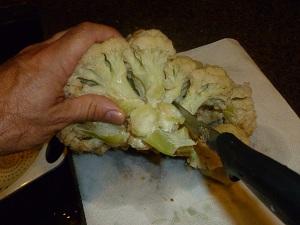 Step 3 -Split the cauliflower
Step 3 -Split the cauliflower
Select firm, young, heads. Split lengthwise so flowerets are no more than 1 1/2
inches across. Remove leaves.
Step 4 - Soak the florets in brine (salt water)
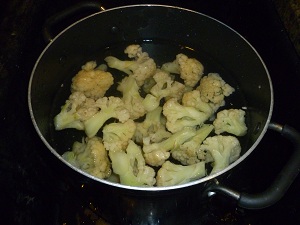 Soak the cauliflower in brine (4 teaspoons salt to 1 gallon ordinary tap
water) for 30 minutes to remove insects. Then rinse under fast cold running
water.
Soak the cauliflower in brine (4 teaspoons salt to 1 gallon ordinary tap
water) for 30 minutes to remove insects. Then rinse under fast cold running
water.
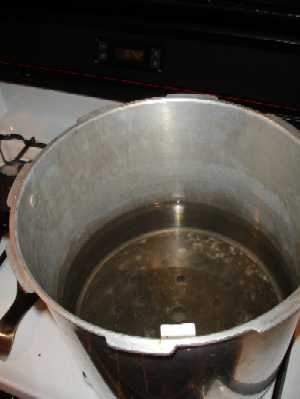
Step 5- Get the pots ready
Get
the pot of boiling water ready (about 2/3 filled) and a LARGE bowl with
ice and cold water.
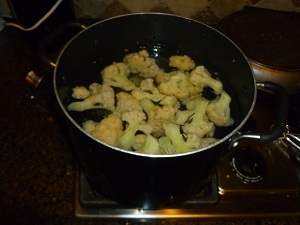 Step 6 - Blanch the cauliflower.
Step 6 - Blanch the cauliflower.
All fruits and vegetables contain enzymes and bacteria
that, over time, break down the destroy nutrients and change the color,
flavor, and texture of food during frozen storage. cauliflower requires a
brief heat treatment, called blanching, in boiling water or steam,
to destroy the enzymes before freezing. Blanching times for cauliflower is 3
minutes (or blanch with steam for 5 minutes) - the duration is just
long enough to stop the action of the enzymes and kill the bacteria.
Begin counting the blanching time as soon as you place the
cauliflower in the boiling water. Cover the kettle and boil at a high
temperature for the required length of time. You may use the same
blanching water several times (up to 5). Be sure to add more hot water
from the tap from time to time to keep the water level at the required
height.
Step 7 - Cool the cauliflower
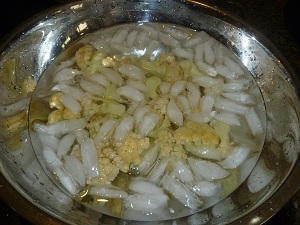
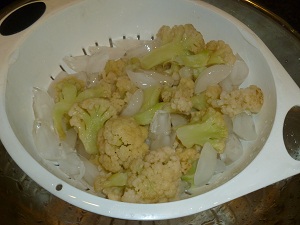 Cool
cauliflower immediately in ice water. Drain the cauliflower thoroughly (this
shouldn't take more than a minute).
Cool
cauliflower immediately in ice water. Drain the cauliflower thoroughly (this
shouldn't take more than a minute).
After vegetables are blanched, cool them quickly to prevent
overcooking. Plunge the cauliflower into a large quantity of ice-cold water
(I keep adding more ice to it). A good rule of thumb: Cool for the same
amount of time as the blanch step. For instance, if you blanch sweet
cauliflower for 3 minutes, then cool in ice water for at least 3 minutes.
Drain thoroughly.
Step 8 - Bag the cauliflower
I
love the FoodSavers (see
this page for more information) with their vacuum sealing! I am
not paid by them, but these things really work. If you don't have
one, ziploc bags work, too, but it is hard to get as much air out of the
bags. Remove the air to prevent drying and freezer burn. If
you don't have a foodsaver, see two more methods for removing air, below.
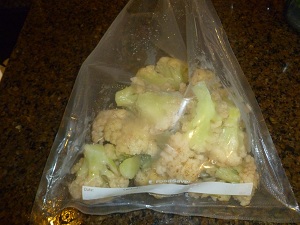
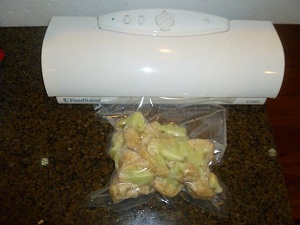
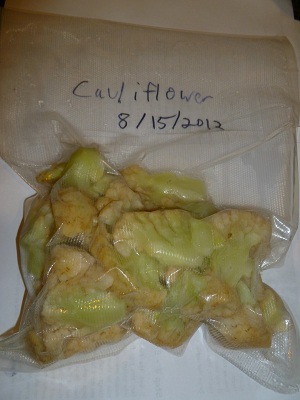
Method 2
Or hold the open bag underwater (keeping the open edge ABOVE water).
The water presure will push most of the air out). Seal it while it is
still in the water. This
method gets out most of the air, but the foodsaver gets out twice as much
air.
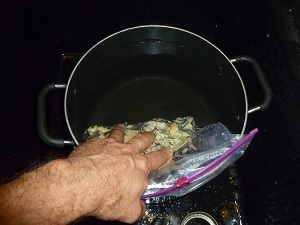
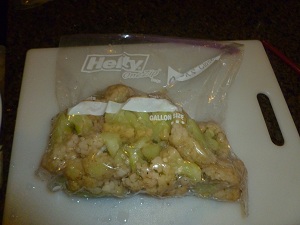
Method 3 - The least effective method is the straw:
If you don't own a vacuum food sealer to freeze foods, place food in a
Ziploc bags, zip the top shut but leave enough space to insert the tip of
a soda straw. When straw is in place, remove air by sucking the air out.
To remove straw, press straw closed where inserted and finish pressing the
bag closed as you remove straw.
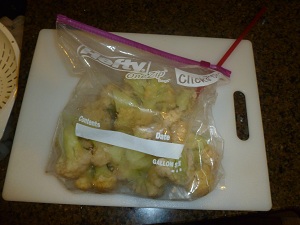
Step 9 - Done!
Pop them into the freezer, on the quick freeze shelf, if you have one!
I love the FoodSavers (see
this page for more information) with their vacuum sealing!
Here's
an example of one model:
FoodSaver V2840 Advanced Design
This one is the least expensive of the Food Saver models that has all the
advamced features, like automatic bag detection and sealing, which makes it
faster and easier to seal. And yes, you can seal and freeze foods with
liquids (just freeze the unsealed bag in the freezer overnight, THEN seal
it!)

About $135
 
Features
- Home vacuum-packaging system vacuums, seals, and shuts off
automatically
- Upright vacuum-sealing
appliance with SmartSeal technology keeps food fresh longer
-
Push-button operation;
built-in roll storage and cutter; automatic liquid detection
-
Crush-free instant seal;
2 vacuum speeds; 2 seal levels; progress lights; integrated
bag opener
-
Marinate and canister
modes; includes 3 quart-size bags, 2 gallon-size bags, and a
roll of bag material
-
Measures approximately 6
by 18-8/9 by 10-2/5 inches; 1-year limited warranty
|
Tips:
- Harvest early in the morning, especially if the weather is hot, to get
peak flavor.
- Harvest the cauliflower at its peak maturity (firm, straight, no florets
opening, dark green, not yellowing)
- Process promptly after harvesting, or keep cooled in the fridge or with
ice until then.
Frequently Asked Questions
- I've frozen cauliflower but it seem so limp and fell apart. Any idea why?
Generally, that means the cauliflower was overcooked. It only takes 90 seconds
in steam or boiling water to heat/cook the cauliflower after removing it from
the freezer
- How long can they be frozen?
It depends upon how cold is your freezer and how you packed them. Colder
(deep freezes) are better than frost free compartments, which actually cycle
above freezing (that's how they melt the ice). Vacuum packing results in
longer storage capability, too. Thicker bags also help prevent freezer
burn.
In general, up to 9 months in a ziploc bag in an ordinary freezer, and 14
months in a deep freeze in a vacuum packed bag. After that, they
cauliflower
won't make you sick; they just won't taste a s good.
Comments and Feedback
- A visitor writes on July 02, 2016: "Used your freeze
cauliflower last night and it was so easy and it turned out so wonderful
thank you,"
- A visitor writes on October 07, 2013: "I used your page to
freeze some cauliflower today. It was my first time freezing fresh
veggies. Your directions were so clear & I loved the "hold the bag
underwater to remove air" tip! Tomorrow I will freeze some spinach. I
made a $10 donation in thanks to you. Sincerely, Pam in Maryland, USA"





